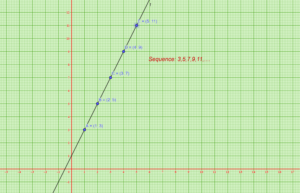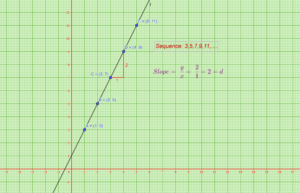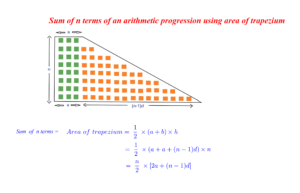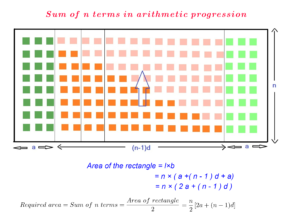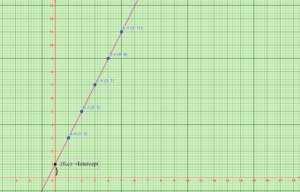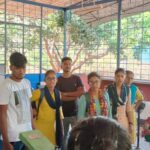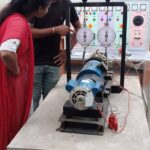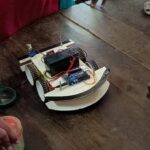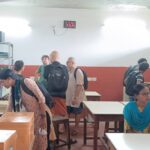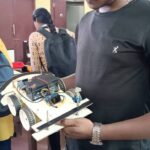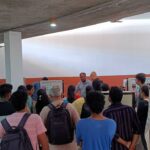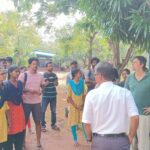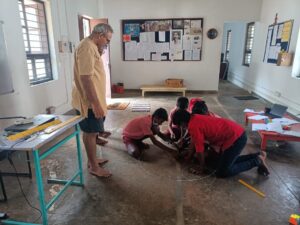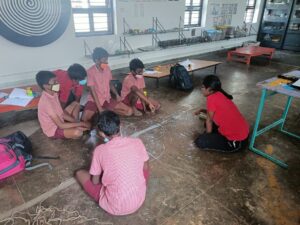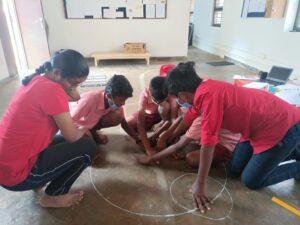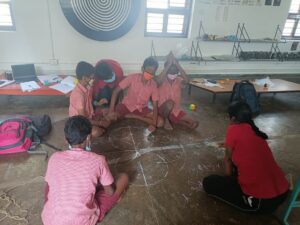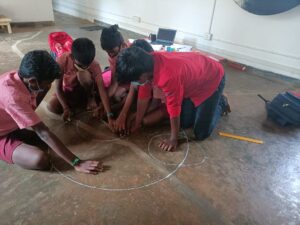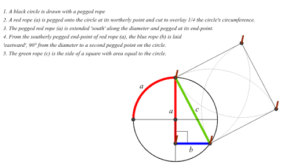The possible missing ingredients in Engineering higher education –Mastering self, agency to shift disempowering Norms and Socialization and mastering technical skills
Arun Arulselvam (arunarul677@gmail.com), Narmadha Anandavelu (narmadha29101997@gmail.com), Santhosh Kathiresan (sandykias@gmail.com) , Sivaraman Ramamoorthy (aurosivaraman@gmail.com) , Sri Bhavani Arul (sribhavani1998@gmail.com), Sanjeev Ranganathan (sanjeev.ranganathan@gmail.com)
C3STREAM Land Designs
Engineering higher education in India, especially rural India, does little to help youth learn about the universal values they stand for or develop their inner capacity, or develop agency to address disempowering socializations, it does not even prepare youth with practical industry ready skills. What possible missing ingredients when put in place would prepare youth for a effective and meaningful life for themselves and others? This paper is an autoethnography of five youth who are completing a one-year residential program called “Being and Becoming a Shifu (Master)”. We present how the program added these missing components in helping us connect with universal values, develop system thinking and five minds of the future, confidence in skills, being independent and interdependent and self-assessment.
RESEARCH QUESTIONS
The one year Becoming and Being a Shifu (Master) (BnBShifu) program helped us youth understand what we care about, increased self-awareness, self-regulation, responsibility, and develop confidence technical skills of VLSI (Very Large Scale Integration) layout and programming. It helped us notice our own socialization, develop system thinking. This helped develop the five minds of the future – disciplined mind, ethical mind, respectful mind, synthesizing mind and creative mind. We reflect on ‘how this happened’, or perhaps, how this could happen in Higher Education (HE) with practices at BnBShifu and its impact on us:
1) How did the program encourage youth to connect to their universal values (universal values apply for everyone, everywhere such as dignity, equity, courage)?
2) How did the program support develop system thinking, noticing patterns and five minds of the future?
3) How did the program build confidence in skills and in competence to move from being dependent to independent to interdependent?
4) How did the program provide timely feedback and build the ability of self-assessment?
We refer to universal values as those that can be embodied by everyone, everywhere irrespective of their caste, culture, gender, age, etc such as dignity, equity, courage. These form the basis of sustainable and equitable change for a thriving people and planet. When we source universal values, and express them through strategic action, multitudes of initiatives come alive, and a vast array of ideas find expression based on our aspirations, interests, and talents. Our independence is wholesome through our interdependence.
We distinguish these from the common uses of the word values in different contexts such as – something important; or a socialized culture (of a specific group, caste, or religion e.g. how women/men should dress); or in business as money added at a stage in a value chain; or as operating principles (e.g. excellence in academia, privacy in online transactions) which varies with context.
higher education in India: challengeS & opportunities
The quality of the HE institutions and colleges in India is not on par with other countries like China, Singapore (Singh, 2011). Singh states that some of the institutions are run as a profitable business where the rural and semi urban pupils are trapped. In our county 68 percent of the country’s universities and 90 percent of colleges are “Middle or poor quality”. He recommends institutional sharing between high quality institutions and these to take them to the next level. (Sheikh, 2017) suggests an alternative paradigm of new-age online learning tools to address various challenges of Indian higher education and to bring equity. Contemporary research (Manya, 2020) indicates that the Indian Education system is concentrated more on the marks rather than giving importance to the skill that has been built. Specifically, the unemployment in Engineering graduates is due to a lack of skill and competence (Tilak, 2021). Tilak shares that technology is transforming the labour market across the world 80 percent of Indian engineers are not fit for any of these jobs. India needs to interlink academia and industry.
To improve learning outcomes in HE (Harackiewicz & Priniski, 2017) suggests targeted interventions in how students value their tasks, how they engage with their academic work and their communication with their professors. Across domains students who framed their academic challenges and could self-reflect were more motivated and had better outcomes. Other solutions are linked to the need for feedback in improving the learning experience for the students in HE (Bashir, Kabir, & Rahman, 2016). That providing quality information to students about their learning and feedback to the students develops the ability of students in self-assessment.
Further there is a question of what HE should inculcate. (Ronald, 1990) argues the hidden understanding of HE beyond economics is the need to develop physiological and sociological perspective in students. Ronald highlights certain points that can be included in HE like self-reflection, open learning, group activities, interdisciplinary learning that can lead to developing these aspects.
We feel that the five minds of the future (Gardner, 2005) synthesize what is needed by youth – the disciplined mind (understanding, application and memory) for skills, the respectful mind (dignity for all), the ethical mind (human unity) caring for people and planet, the synthesizing mind (ability to notice patterns) and shift unhealthy socialization and creative mind for new solutions from care as distinguished from innovation which is only a function of the mind.
In this paper, we will look at how the BnBShifu program which offered no marks or certification developed our skill, competence and inner capacity. It started with connecting us to our potential or inner values and developing technical skills needed in the industry embracing the solutions suggested in literature including feedback from mentors, self-assessment, setting targets, peer learning, using rich online resources.
research methodology
The primary research methodology is autoethnography based on reflections of five youth (represented as ShifuX: Shifu1, Shifu2, etc respecting the blind review process) who are completing (11 months) the BnBShifu program. We feel that a methodology based on reflection is appropriate as we are addressing the lack of the reflection in youth and in our education system. We hope multiple reflections mitigate the weakness of autoethnography of not to being general enough. The gaps in HE described in literature is our lived experience as engineering graduates in rural India. We hope what was useful for us in BnBShifu will be useful for further interventions at scale.
Based on general reflections on the program we came up with questions that we felt might give a framework for us to synthesize our experience making it relevant for a broader audience. We then recorded our reflections for these questions. Given the limited length of the paper we have been selective in sharing insights and may have cut them short with ‘…’ in the hope to bring a new point. We have also dropped a question regarding how the program helped us develop healthy living which we felt was important to share with youth, but we realize many aspects were possible due to the residential nature of the course and may not be scalable. We will make all responses including those of a couple of new joiners (3 months) of the BnBShifu program available online after the review process (Arun, Narmada, et.al, 2022).
Background of participants of bnbshifu program
Sharing our background before we joined the BnBShifu program may aid understanding our reflections. We all studied engineering in colleges in villages around tier-II/III cities as shown in Table 1.
| Who |
Age |
Course |
M/F |
College Location |
Work-ex |
| Shifu1 Kathiresan.S |
23 |
B.Tech. EEE |
M |
Ariyur, Puducherry |
0 |
| Shifu2
Arul.S |
23 |
B.Tech. ECE |
F |
Serumavilangai, Karaikal |
8 months |
| Shifu3 Anandavelu.N |
24 |
B.Tech. ECE |
F |
Serumavilangai, Karaikal |
0 |
| Shifu4 Arulselvam.A |
24 |
B.E. EEE |
M |
Chellankuppam, Cuddalore |
1 year |
| Shifu5
Ramamoorthy.S |
24 |
B.E. ECE |
M |
Mailam, Villupuram |
9 months |
Table 1: Background of participants of the BnBShifu program (and authors of this paper).
Shifu1: In my college they focused only on marks and I memorized to clear all papers and not get arrears. I could tell the memorized definitions, but had no in depth to explain further. Sometimes I even forgot the definitions as I had not understood them. Even in practical exams I memorized the circuit connection by using a manual. When asked, the lab staff did not offer us an explanation of how things worked as they felt it was not needed to pass the examination.
Shifu2: …I thought scoring high marks will help me to get a job in the tech industry. After college, I got a job as a data entry operator. There was no progress in my learning except achieving targets. There I didn’t get time to take care of my health or engage in any other S
reflections to describe the BnBShifu program
Shifu4: When I first heard about the program, I thought that it will be like other usual courses of training in programming, but it was totally different from my imagination.
The application form itself was completely different from anything I had ever seen. It asked about personal information (e.g. biodata), personal knowledge (e.g. if I prefer to work early in the mornings or late at night) and personal wisdom about self-analysis, self-awareness, self-regulation, responsibility. Especially the wisdom section where they asked for universal value, cultural shift, responsibility, and healthy habits was a different experience for me and made me think.
We started the day with Surya Namaskar, running and Anna Paana meditation. We then had team meetings often with RTL (Radical transformation leadership) training sessions (Monica, 2017) and then we concentrated on learning skills and then I practiced to make myself perfect.
We interacted with each other and with our mentors to learn and also had sports or gym in the evening, at times we watched TED talk and reflected on it and the day was completed with book reading and daily reflection.
The RTL program helped me to find what I stand for and be one with my universal value; the program offers tools, templates and distinctions that connect real-life experiences and help me see problems from my universal values and come up with solutions that are in line with them and the shift I want to see in the world. It helped me address my bias and socialized fears and gave me a path to overcome them…
Shifu1: In this program I learned I stand for kindness and equity for myself and others. I committed to spending a year in the Shifu program as an input from my side. The output of the program was that I learned VLSI layout, programming in Scratch¸ Python & SKILL, Radical Transformation Leadership (RTL), Spoken English, Maths class, Book reading session, and Vipassana (VRI, 2010)… I learned to meditate and notice myself. I also changed my food pattern to a healthier diet and avoid snacking… I joined the program for technical knowledge, but here, I also learned useful life skills and RTL tools. The program also gave me time and space to think about the purpose of my life…to notice that only earning is not going to fulfill my life so I learned to serve and help others. I started teaching children (in my last semester) what I know, while teaching, I noticed that I’m also learning from them.
Shifu3: …Here the first one or two weeks it felt that we were doing so many things like learning technical skills, sport, meditation, and following ground rules…But, as I settled in, I learned time management and created time for everything to have an enriching day, each day…We also had access to STEM land a space with games and puzzles created for children where I went to learn and refresh myself. Every week we visited some places in Auroville and met new people who they shared how they are serving the community and what they care about and I was inspired to be courageous and independent like them. Once a week we also presented what we learned to others. Everyone in the program had taken up accountability like managing the kitchen, finance, maintenance, and so on this made me more responsible and accountable.
An important point that came up in all reflections was developing good habits of being disciplined about eating times, and being healthy mentally and physically.
reflections on the research questions
1) How did the program encourage youth to connect to their universal values*?
Shifu1: All of us have universal values within us, but we do not notice them or not act from them. This program had RTL which helped me think about my universal values I really care about for myself and others. Whenever I share an insight, I start by sharing my universal values. I stand for equity and kindness for myself and for others. When I keep on telling my universal values they became automatic I acted though equity and kindness. The words allow me to connect to what I deeply care about, but I’m not stuck to the words and understand their essence is to make me better. I believe RTL tools, templates and distinctions can also support youth to connect to their universal values.
Shifu2: I learned who I am being when I am at my best i.e. the universal values I hold within. I noticed that what I admire in others are qualities I want to develop within me. After discovering my universal values, I started to work from them. It made me think differently of how I can handle situations. I started to notice situations when I was not in my universal values and reflect and shift my mindset. The impact and outcome of practicing some RTL tools is it made me notice my own bias towards genderism and my own background conversations.
Shifu3: This program helps me become more self-aware and I discovered the inner values I stand for equality and happiness, through RTL. I used tools in RTL to overcome my fear and work courageously. It also made me aware of what I am doing in every situation and I learnt how to process experiences and learn from them. I started to design my projects using CFSR. I can breakdown the problem and what are the actions I can do differently to progress. I learned to be responsible.
Shifu4: …It starts with the searching what a person deeply cares about and makes him/her understand their stand… It helped me change my mentality from caring only for ‘me, myself and I’ to caring for ‘myself and others’. In addition, the Shifu program supported my problem-solving ability even technically and gave me confidence in facing the problems instead of getting into fears…We had ten days of Vipassana meditation which helped me to come out of my cravings and accept the reality to move forward. It helped to develop a concentrated mind.
Shifu5: The complete awareness of my values and for what I stand for came after attending RTL workshop…Here the values have important essence of connection for goodwill, strength and supportiveness for everyone universally.
2) How did the program support develop system thinking, noticing patterns and five minds of the future?
Shifu5: The Disciplined mind: …The program gave me the time stay with topic till I understood, applied and remembered it. I found this way of learning to be an investment for my life and it stood as a north star for my life as a programmer and being human.
The Respectful mind: Here the learning was without hierarchy. Learning from each other and supporting others to learn emphasized respect for everyone…
The Ethical mind: Vipassana meditation helped me be moral and dignified and supported put the RTL tools in practice not only being moral, ethical, but also integral (whole)…
The Synthesizing mind: …I used to memorize information, but synthesising helped me retain and look for patterns and use learning in other contexts. This included learning programming and problem solving in code-wars, reflections at the end of the day, processing a TED talk or a workshop.
The Creative mind: There are no ready-made answers to important challenges and I learned to be creative and adapt. There can be one good answer, but I learned to look for alternative possibilities that emphasis goodwill…
Shifu2: …After I learned the basics, I completed a task in that domain. After completing several tasks, I worked to synthesize the new ideas that I learned. Then I connected new learning with what I already knew. This helped me to learn new domains easily… When I heard presentations from others summarizing what they had learned and I needed to present my own learning I learned to synthesize.
Shifu3: …Initially, I wondered why with VLSI specialization I was learning programming, but as we went along I realized that I had developed my logical thinking, problem solving and automation that I applied to my specialization. I applied logical thinking in the electronics lab and the process of taking small tasks and going in depth and completing it helped me learn something new that I can use to work efficiently in the next task.
3) How did the program build confidence in skills and in competence to move from being dependent to independent to interdependent?
Shifu1: When I was new to this program, we experienced doing experiments in an electronics lab… I never had this kind of exposure in my college to do individual work…
Shifu2: Initially, I was dependent on my mentor to learn new techniques and skills in VLSI layout, then I was given tasks. As I completed tasks, I felt more confident to work independently. I noticed it took more time to complete tasks alone as compared to when I had peers who I could talk to. Sharing of new learning and discussing with peers made me feel interdependent and more efficient. This built my confidence and faith in working as a team.
Shifu5: Before joining BnBShifu I thought I’m not the type to learn programming. In the program a personal mentor guided me based on my capability. I was introduced to learning at my own pace using Coursera platform that was project based. Every time I made a project, I felt more confident. When I got stuck, I got the support of my mentor who would ask me questions rather than just give answers. After that I was introduced to code-wars a website for challenges in coding at various levels. Here, I needed to pick my challenge and I started to understand where my level was and could see how I was able to take up challenges at higher levels as I got better in programming. I became independent and could assess what I was capable of. Relating what I do with my values and in resonance with the five minds of the future gave me interdependence.
4) How did the program built the ability of self-assessment as well as provide timely feedback?
Shifu1: In this program we had an opportunity to record our insights – reflections about what I learned and about how I feel here in our daily reflections. Our mentors read and interacted with us and this helped to clear our doubts in the same day itself…
Shifu2: Getting the input and feedback from my mentors, helped me to level up my state of progress. In technical skills, mentors supported me and gave feedback that helped me notice my gaps. In time, I started noticing my own gaps and this self-assessment had a major role in my progress and learning e.g. noticing how much time I took, what ideas from a previous tasks I could have used to complete this task.
Shifu3: In college I just got marks and neither got feedback from my teachers nor did I find where I made mistakes to correct myself. But in the BnBShifu program mentors supported me by giving feedback for growth (increase, decrease, retain) to improve myself helping me identify where I was and progress swiftly.
Shifu5: I feel self-assessment of looking at patterns of how I did things and how I can make it better is the best way of assessment and helps get many creative answers. This gave me courage to neither give up if I don’t get the answer nor stop with a single answer…
Acknowledgements
To all involved in every way that made the BnBShifu program possible. We especially thank our mentors, Asha volunteers such as Anuradha, Balaji, Swati who supported and enriched the program. We thank Aura Semiconductor, Quilt.AI and Udavi school who provided the infrastructure for the program.
Conclusions
We the youth describe the missing ingredients of our education system were experienced in BnBShifu program. Here we built our leadership skills through RTL training that helped us learn what universal values we deeply cared about and want to manifest in the world building our respectful, ethical and creative mind. We developed our disciplined mind with the support of challenge-based online courses like Coursera and platforms like code-wars and practiced self-learning, peer learning, presentations, feedback and got guidance from mentors (practitioners). We developed our synthesizing mind with daily reflections, using RTL tools to process experiences and presenting what we learned technically to peers. We had access to practitioner mentors who asked us questions rather than give answers and gave feedback that helped us notice gaps and build self-assessment. As we built projects we moved from dependence, to independence to interdependence in creating a learning community with peers. There were no specific teachers, professors, no marks or certificates and yet we learned an found meaningful employment. We work in the areas of VLSI layout, software design and design automation while putting aside time to support others learn what we know as others who invested in us through the BnBShifu program. The third area design automation is a combination of the first two and was created as the program progressed.
We feel responsible to question status quo in the norms of our education system and to showcase what needs to be added to make the education system whole. We hope these ideas from this program will be scaled to benefit rural youth like us in India.
References
Bashir, M.M.A., Kabir, M.R., & Rahman, I. (2016). The Value and Effectiveness of Feedback in Improving Students’ Learning and Professionalizing Teaching in Higher Education. Journal of Education and Practice Vol.7, No.16. https://files.eric.ed.gov/Fulltext/EJ1105282
Gardner, H. (2005). Five Minds for the Future, Harvard Business School Press.
Harackiewicz, J.M., & Priniski, S., J. (2017, September). Improving Student Outcomes in Higher Education: The Science of Targeted Intervention. The Annual Review of Psychology (pp. 11.1–11.27)
Manya, J. (2020, January). A study of India’s failing education system. XXI Annual International Conference Proceedings (pp.138-149). https://tinyurl.com/bdf5bekr
Monica. S. (2017). Radical Transformational Leadership: Strategic Action for Change, North Atlantic Publishing, at Berkeley, California (pp.2-6).
Ronald, B. (1990). The Idea of Higher Education, McGraw-Hill Education (UK)
Sheikh, Y.A. (2017) Higher Education in India: Challenges and Opportunities, Journal of Education and Practice. Vol.8, No.1.
Singh, J.D. (2011, June). Higher Education in India – Issues, Challenges and Suggestions. Higher Education (pp.93-103). Lambert Academic Publishing. https://tinyurl.com/42v3ac7r
Tilak, J.B.G. (2021, March). Employment and Employability of Engineering Graduates in India. Journal of Contemporary Educational Research. https://tinyurl.com/4jaj8v6u
VRI, (2010). What is Vipassana? https://www.vridhamma.org/What-is-Vipassana
